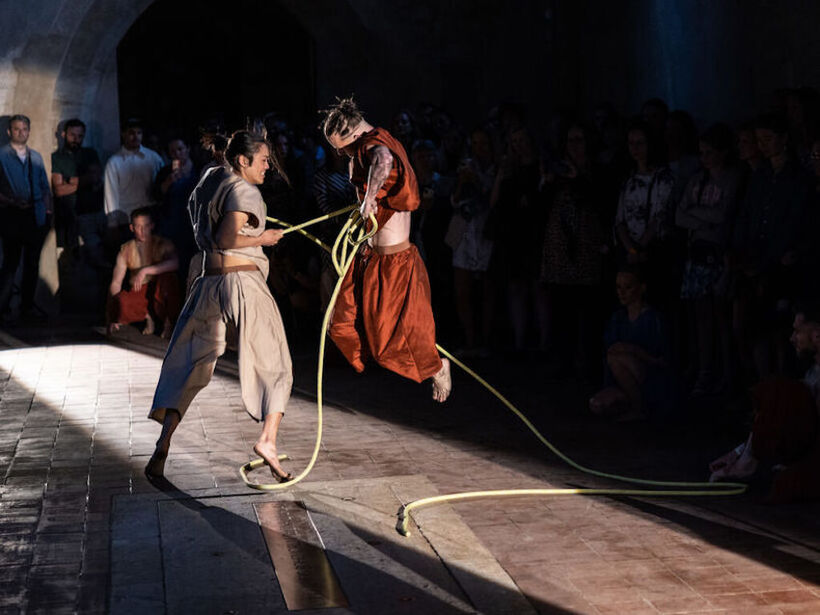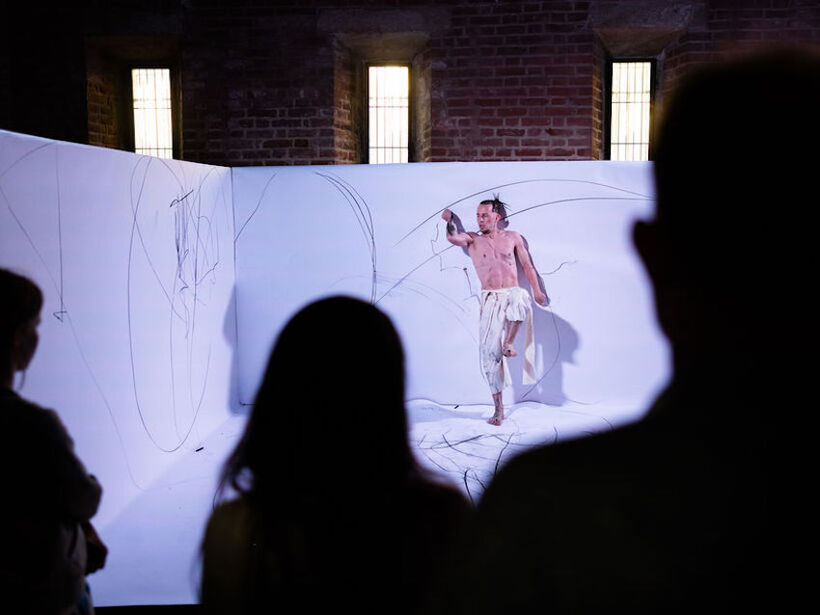Sancti – The power of words
It has become almost a tradition that the Losers Cirque Company, in the late spring days, with a bridge to the holidays, settled next to the BRAVO! Theatre in the area of the Convent of St Agnes of Bohemia in Prague's František district. While the previous three summer seasons have seen the acrobats stick mainly to the outdoor stage, this time around they along with their audience, headed to the stone interior. The audiovisual walk Sancti, a site-specific drama-acrobatic performance, presented legends of important Saints associated with Czech history or with kind humanity and martyrdom in general.
The guide, the undisputed backbone of the performance, was Justin Svoboda. He not only attracted attention by his verbal expression, i.e. not only by what he said but especially by how he said it and was heard at all times. For example, by the colour of his voice, the volume and phrasing of his speech, he was able to draw us into listening to stories about St Agnes, Duke Wenceslas, St Lawrence and St Francis of Assisi. There could have been eight, perhaps nine individual stops, some for a long time, others just for a moment. The chosen format, even evoking a hero celebrating summer camp play or larp, combined word and song, motivated movement with gestural support, modern expressive dance, and ground and aerial acrobatics with an impressive genius loci. Moreover, as time progressed, the architecture was overlaid by dusk and shrouded by darkness, which was magically played with by Michael Bláha's light composition.
After hearing the prologue, the large audience moved into the rain-soaked garden, where they watched the "grilling" of St. Lawrence, acrobatically represented by spinning on a suspended trapeze above the tree line. Then the spectator entered the corridors of the former monastery and, by the cumulative effect of all the staging levels, was given the opportunity to let the weight of history, the courage of the Saints and the Martyrs and, unfortunately, the reality that in such a large number of spectators, the time of transfers exceeded the level of personal immersion and that it was not possible, especially in the first half, to catch or see even a slice of the action in some of the cramped spaces.
Despite these setbacks, the impressive place was the ambit, through which the singers of the Maranatha Gospel Choir passed and managed to infuse the whole space with their voices, in which the acrobats swarmed or moved like animated installations. The movement variations acted as either an unobtrusive colouring of the action or an acute and compelling component of the story. The performances on all levels, with anoccasional emphasis on effects and more or less harmonious genres, were especially striking, ranging from the fraternal quarrel to the recitation of the letter of St. Clare of Assisi to Agnes of Přemysl to the final "show".
The unforgiving duel between two ducal brothers featured Tomáš Pražák (Boleslav) and Taro Tamura (St. Wenceslas). Both experienced performers with distinctive physical capabilities managed to dominate the arena. They built tension artfully and with a strong contribution of the rope as an object mediating the metaphor of their dialogue. They were flexible and unyielding, wrestling with each other and with the rope, yet the warriors' physical persuasiveness clearly loomed over all the difficulties.
In the following, group acrobatic sequence, the members of Losers Cirque Company were given space to showcase their skills, which the regular viewer has seen countless times, but here they were incorporated into an escalating series of actions running in parallel with growing emotions and an effort to convey an emotionally powerful message. For the conclusion, and arguably the longest tableau, the creators created an auditorium surrounding the stage on three sides, complete with a white tarp-covered trampoline at the back. The visually very appealing jumps, evoking a flight to the heavens, at times seemed to overshadow the foreground. Both jumpers successfully and literally raised the action to the heights.
However, there was also the question of taste and unity of the dramaturgy, whether it was necessary to go beyond the established hierarchy from church choruses to a musical-like number, from respectable acrobatic risks in the church nave to overused "swings" and from sophisticated narration to tremblingly sung words. The craved calm, which for various and mostly capacity reasons was essentially absent during the journey, came only in a few shuddering seconds when, after the last note, there was a grave silence before the explosive applause.
In Sancti, the creators have found the potential to communicate in words and body, and have successfully resisted the seductive pathos of the monastery spaces. It was certainly an attractive experience, whether in terms of the unusual combination of movement expression with architecture, or the specific form of the tour encouraging a desire to learn more deeply about the history of the monastery and the stories of the Saints. After all, even such a form of "enlightenment", "education" is extremely beneficial and important these days.
Written from a performance on 5 June 2023, St Agnes Monastery.
Sancti
Script: Justin Svoboda, Petr Horníček, Michaela Kadlčíková
Directors: Justin Svoboda, Petr Horníček
Choreography: Michaela Kadlčíková
Music: Josefína Horníčková, Radim Gačev
Sound design: Karel Mařík
Singers: Maranatha Gospel Choir
Costumes: Lucie Červíková
Light design: Michael Bláha
Performers: Justin Svoboda, Sára Stoulilová, Karolína Maštalíř Křížková, Nikol Kopáčová, Tomáš Pražák, Petr Dvořák, Petr Dlugoš, Jiří Bělka, Lukáš Borik, Taro Tamura, Petr Dufek, Adam Sült




.jpg)
.jpg)